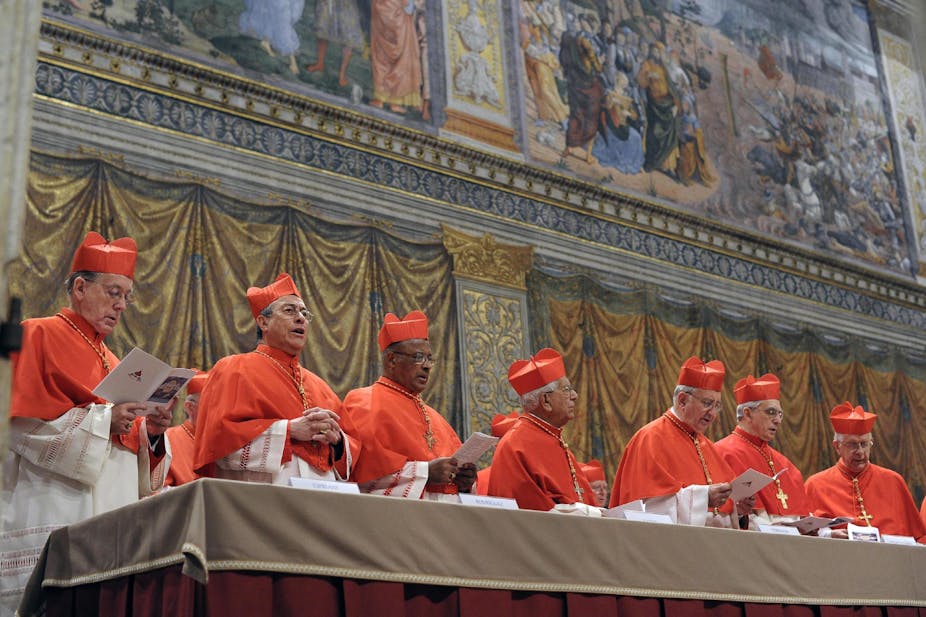This morning, Australian Catholics awoke to the news that black smoke billowed from the chimney of the Sistine Chapel. The seat remains vacant, there is no Pope.
By now many of us will have learned through the media that conclave means “with key” (cum clave), and that the Sistine chapel is bug-free, but the sense of mystery that surrounds the papal elections remains. What is really happening under Michelangelo’s frescoes?
In fact, there is no mystery. The Cardinals are doing exactly what is outlined by Universi Dominici Gregis – the canon law of the conclave. Similar processes have been in place since 1274 AD.
Cardinals younger than 80 are permitted to vote for a new Pope. Yesterday, they attended mass before being sealed inside the Sistine Chapel. The conclave, guided by prayer, then cast their vote as to who will best serve and guide the church, whilst also serving as its figurehead and as a moral leader for the world.
The first step in the voting process is to distribute the ballots. First, the Junior Cardinal Deacon will draw nine Cardinals’ (now called the “Grand Electors”) names from a lot. The first three will serve as scrutineers, checking and recording each vote; the second three will serve as “infirmarians”, collecting the votes of Cardinals too ill to be present in the conclave; the third three will be revisers – the scrutineers of the scrutineers.
Before voting begins, all non-voters except the Junior Cardinal Deacon will vacate the Chapel, which is then locked from the inside. Each Cardinal takes his ballot, which reads “Eligo in Summum Pontificem” (I elect as Supreme Pontiff), and underneath writes the name of his vote. He publicly and visibly places his vote onto the paten, a gold plate on which the Eucharist is usually held, from which it slides into an urn holding the votes. In mass, the paten holds a host which is later transformed into the body of Christ; so too it holds the votes which transform a man into Christ’s Vicar on Earth.

The next process is perhaps the most interesting: the counting of the votes. First, the now-filled urn is shaken to preserve total anonymity (the Electors are even asked not to write in their usual handwriting), before each vote is taken and read by each of the three scrutineers, who note each vote on paper. The third reads the vote aloud before sewing each vote to the next, so none are lost.
The votes are counted to see if any candidate has reached “scrutiny”, a two-thirds majority (or two thirds plus one when two thirds is not a whole number). Only when a two-thirds majority is reached can a candidate be offered the papacy. If the majority is not reached, the ballots are burned in a stove in the Sistine Chapel, and black smoke is seen from the chimney of the Vatican.
If the majority is reached, the popular candidate either accepts or rejects the position. If he accepts, he nominates a name by which he will be known as Pope. The ballots are burned with a chemical and white smoke is seen from the Vatican. At this point the announcement is made – “Habemus Papam!” – and the new Pope is welcomed from the Papal balcony overlooking St. Peter’s Square.

For many, the process is less interesting than the politics. The conclave requires Cardinals to sever communication with the outside world during the election, but voting blocs do emerge, reflecting differing opinions about the Church’s future. Very little is known about this process, as the Cardinals usually adhere closely to their oaths of secrecy; the breach of which is punishable by excommunication.
Although Vatican journalists, Catholic insiders and even betting agencies make predictions on the next Pope, the Church has always taught that the decision comes down to the 120 or so men in the Sistine Chapel, and God.
Pope John Paul II was entirely unpredicted, and many “experts” thought Ratzinger would never become Pope. With this said, it might be worth reading up on Cardinal Schonborn (Austria), Cardinal Scola (Italy), Cardinal Turkson (Ghana), Cardinal Tagle (Phillipines), Cardinal Braz de Aviz (Brazil), Cardinal Sandri (Argentina), Cardinals Dolan & O’Malley (USA) and Cardinal Oulett (Canada) for an idea of what the next Pope might be like.
In this particular election, many will be looking for a strong leader who can focus on resolving dilemmas in the Vatican bureaucracy, meaning academic men like Schonborn may be overlooked. Others may seek a leader to stall the dwindling numbers of Catholics in the West, and guide the Church through current sexual abuse scandals, where O’Malley or Dolan becomes appealing. For others, the desire for a “third world” Pope makes Turkson, Tagle, Aviz or Sandri viable.
If the old Vatican saying, “he who enters conclave a Pope leaves as a Cardinal” is anything to go by, the next Pope will probably be none of these men, but it is fitting that a man responsible with safeguarding the traditions and beliefs of the Catholic Church is born out of one of its oldest and most famous traditions.

